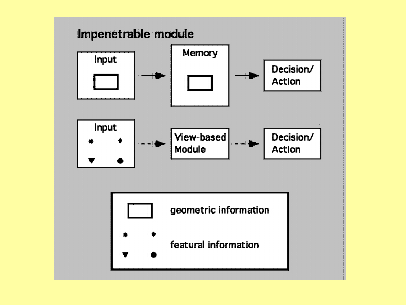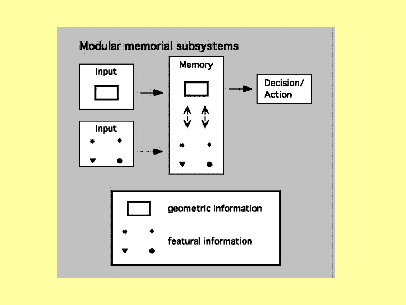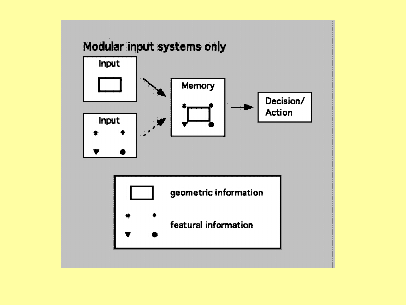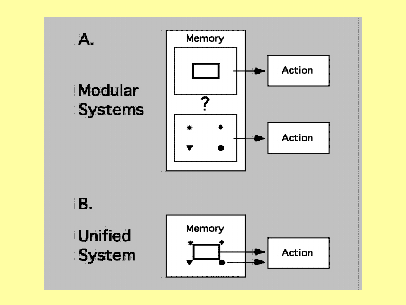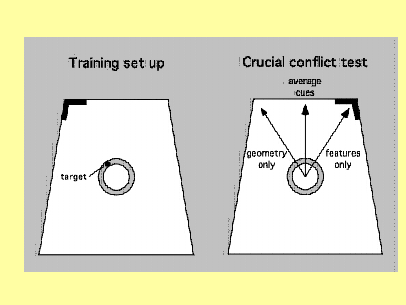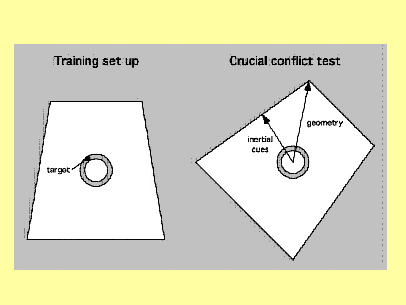Geometry, features, and orientation in vertebrate
animals: A pictorial review
Ken Cheng and Nora S. Newcombe
Introduction: Modularity
|
|
| Figure A-1:
In a strong view of modularity (Wang &
Spelke, 2002, 2003), geometric information
goes through an impenetrable module that
handles only geometric information.
“Impenetrable” means that the module does
not admit any other kind of information.
|
Featural information, if it is used, is handled by other modular systems. We have listed a view-based module as one example. Thus, the systems run parallel through central processing to action.
|
|
|
Figure A-2: A view of modular subcomponents in the central system characterizes Cheng’s (1986) discussion. |
|
|
Figure A-3: In a completely integrated
view (Newcombe, 2002), featural and
geometric information are encoded
together in the central system.
|
Their use may be weighted by many factors, including reliability of information, stability of landmarks, etc. Rotational errors ensue when featural information is either not entered at all into the central system (learning failure), or if they are weighted very little (e.g., because they are thought to be unreliable).
Modularity at output
A different kind of modularity concerns the use of information in guiding action, modularity at output.
|
|
|
Figure A-4: In A., different kinds of
information guide action separately.
They do not interact. In B.,
different kinds of information guide
action together. The information is
integrated at output. We have shown
geometric and featural information
in this picture, but the same notion
also applies to other kinds of
information.
|
Here, we are not concerned with how information is centrally organized (the ? in Figure 4A reflects this uncertainty), but with whether different kinds of information are integrated at output.
|
|
Figure A-5: This idea of modularity at
output is best explained with
concrete experimental examples. In
the training set up here (left) the
search space is the gray ring. The
searcher has the problem of
determining direction: at which
direction from the center of the
ring to search at. Around the ring
are distant cues for direction
determination. We assume that the
animal is disoriented, but it has
unambiguous geometric cues (the
trapezoidal arena) and a featural
cue at the top left corner.
|
After sufficient training, the cues are put in conflict. The featural cue is moved to the top right corner.
Arrows indicate interesting theoretical possibilities. The animal might rely completely on geometric information (left arrow). It might rely completely on the featural cue (right arrow). It might vacillate between the locations dictated by the geometric and the featural cues. Or, it might average the dictates of geometric and featural cues, and search somewhere between the right and left arrows.
This last outcome indicates integration of geometric and
featural information at output.
The vacillation outcome is ambiguous. It might result from the existence of competing modules, or it might occur with integrated representations if the animal computes degree of match between competing locations and finds two imperfect matches.
|
|
Figure A-6: This conceptual paradigm is not
limited to geometric and featural cues.
Consider for example an oriented animal
trained in the training set up on the left.
Its inertial sense of direction and the
geometric cues of the trapezoidal arena both
give directional cues.
|
In Figure 6, the two kinds of cues are put in conflict on the right, when the trapezoidal space is rotated in Earth-based coordinates. This puts geometric and inertial cues in conflict.
Thus, many kinds of cues can be tested in this fashion. One recent theory of the evolution of spatial cognition (Jacobs & Schenk, 2003) suggests that a part of the hippocampus is devoted to determining bearing or direction. If we read these authors right, this bearing system would use all available directional cues in an integrated fashion.
|
